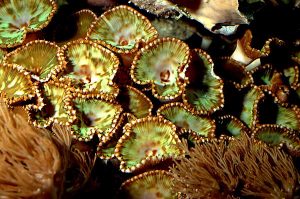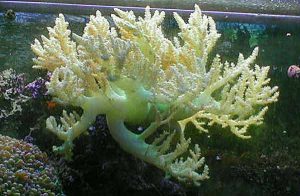In the movie The Medicine Man, Sean Connery portrayed a physician who is sent into the deepest rain forest in search of new tropical agents. His job was to comb through the endemic plant life in search of new drugs, particularly anti-cancer agents that could be used in modern medicine. As the movie unfolds Sean Connery has stumbled upon a plant extract from a bromeliad (a pineapple-like plant) which cures tumors in his lab mice, only to find out greedy land developers are slashing/burning the only area in the world where this plant is found. The bottom line is when this great natural resource is gone, so to is the potential for many of these new medicines.
The above paragraph sets the premise for this column; many of the world reefs contain just such bioactive agents. Scientists are scouring the sea in search of medicines that may work better than conventional drugs with fewer side effects. As an example nature has provided many effective anticancer agents in current use, such as the microbial derived drugs; bleomycin and doxorubicin; and the plant-derived drugs, topotecan, and taxol. The search for novel anti- tumor agents from natural sources continues through collaboration among scientists worldwide in the investigation of coral reefs, and deep subsurface thermal vents for novel bioactive compounds. The potential for drug discovery is further enhanced by recent advances in procedures for microbial cultivation and the extraction of nucleic acids from environmental samples, resulting in the identification of novel microbes that provide a vast untapped reservoir of genetic and metabolic diversity.
For the remainder of my presentation I would like to discuss novel applications and bioactive molecules found in reef dwelling marine organisms (particularly, the ones we keep in our reef tanks) that have shown to possess beneficial therapeutic qualities [1, 2a,b].
Hard corals
Coral skeletons: Coral skeletons are currently used in bone replacements in reconstructive surgeries. Coral structures have a very regular and extensive interconnected pore system, and appear as biocompatible as hydroxyapatite (the current standard for use in bone implants), in the formation of potential bone replacements. In preliminary studies, coral skeletons have been implanted into patients and examined for the shape of new bone, vascular patency, and induction of bone. Upon examination all grafts had viable tissue, and heterotopic bone was formed. The shape of the new bone was the same as that of the coral, and there was no significant inflammatory reaction. Part of the coral in the composite was absorbed into the host. The combination of coral skeletons impregnated with type 1 collagen is more effective in forming autografts with designed shapes than current calcium hydroxyapatite sponges used in maxillofacial reconstruction. Additionally, coral skeletons are less expensive than currently available hydroxyapatite bone implants. [3, 4].
Galaxea: A protein complex called S2 has been isolated from the mucus of G. fascicularis. The S2 complex contains potent anti-topoisomerase activity, causing cytotoxicity to multiple-drug resistant cancer cells. S2 inhibits DNA relaxation catalyzed by topoisomerase I and II. Additionally S2 stabilizes the topoisomerase I-DNA cleavable complex, thereby inhibiting the DNA replication machinery, leading to cell death. The natural application of this complex in Galaxea is most likely to prevent bacterial colonization on the mucus. S2 has potentials of being developed into a new anticancer therapeutic [5].
Soft Corals
It is understood that soft corals produce many toxic agents, these agents allow these sessile invertebrates to effectively compete for space, but I bet you didn’t know how useful these toxic molecules can be medically.
Gorgonians: Pseudopterogorgia elisabethae. Biochemical screening of natural products derived from the sea whip have been shown to have anti- tuberculosis activity. Scientists have identified two diterpine alkaloids which when biologically screened against mycobacterium tuberculosis have shown to posses potent growth inhibitors. These alkaloids are currently being synthesized and will go into phase one clinical testing. [6].
Encrusting Gorgonians Erythropodium caribaeorum. Eleutherobin is a novel natural product isolated from a marine encrusting gorgonian Erythropodium caribaeorum that is extremely potent for inducing tubulin polymerization in vitro and is cytotoxic for cancer cells with an IC50 similar to that of taxol. Taxol is currently one of the most effective FDA approved anticancer agents available for treatment in ovarian, breast, and non-small-cell lung carcinomas. Originally isolated from the bark of the Pacific yew, Taxus brevifolia, it was the first natural product described that stabilized microtubules. However, taxol has many pharmacokinetic limitations (such as multi-drug-resistance (MDR) susceptibility, and lack of aqueous solubility) which make it a less than ideal drug. Eleutherobin shares with taxol the ability to induce tubulin polymerization and is cytotoxic by virtue of this mechanism. However the mechanisms of tublin polyermization by eleutherobin are different than those of taxol induced polymerization. Additionally the drug is water-soluble and appears to overcome multi-drug cross-resistance, making eleutherobin one of the most promising new molecules with “taxol-like” activity [7].
Zoanthids (button polyps): Zoanthids of the genus palythoa [See photo] posses an extremely potent toxin called palytoxin (PTX). PTX is a toxin that blocks cellular Na+/K+-ATPases. Sub-lethal doses of palytoxin have been injected repeatedly into mice bearing tumors, and PTX related effects on reducing tumor tissues have been examined. This toxin has been chemically conjugated to tumor-homing antibodies where the antibody provides a guided missile approach to delivering this lethal warhead. Palytoxin has been reported as the causative agent in mysterious fish death [8].
Interestingly, this toxin is also found in various other marine organisms which live in close association with zoanthid colonies, e.g. sponges (Porifera), soft corals (Alcyonaria), gorgonians (Gorgonaria), mussels, and crustaceans. Additionally, predators of palythoa, e.g. polychaete worms ( Hermodice carunculata ), a sea star ( Acanthaster planci ) and fish ( Chaetodon species) feeding on Palythoa colonies, accumulate high toxin concentrations in their organs, where PTX is stored in its active form [9].
Xenia: a novel diterpene called Xenicane has been isolated from the soft coral Xenia elongata. Interestingly the terpenoid appears to be a fish specific poison, however it has shown some effectiveness at inhibiting mitrochonridia respiration in cancer cells [10,11].
Nephthea: The soft coral Nephthea was found to contain a bioactive compound called lemnabourside. Lemnabourside is a 5alpha-reductase inhibitor which posses the ability to inhibit the conversion of testosterone into the more potent dihydrotestosterone (DHT). The end result is that lemnabourside selectively triggers cell death (apoptosis) in cancer cells. Specifically, it is very active in prostate cancer cells, as they tend to be androgen dependent [12].
Alga
Alga: Two new drugs under investigation by Nereus Pharma are derived from the marine green algae Halimeda (_Halimeda Opuntia_). The drug Halimide [13, 14], a low molecular lectin-like molecule, appears to have hemagglutinating activity, and has shown early promise in treatment of early stage cancer, particularly breast cancers resistant to current chemotherapy. Additionally, in the algae Halimeda Dictostia, a sulfated polysaccharide exhibits a potent antiviral and anticoagulant activity has been identified. This compound known as HALOVIR A, a sulfated galactan has shown antiviral activity against herpes simplex virus. The inhibitory effect of the compound occurs during the adsorption period preventing viral entry into a cell [15].
Scientists have found unique cyclic peptides known as kahalalides in a mollusk which feeds exclusively on the green alga, Bryopsis. In bioassays these kahalides (named A-F) have shown remarkable anti-tumor, antiviral, anti- malarial, and OI (activity against AIDS opportunistic infections) activities [16]. The structure of these peptides is cyclic depsipeptides, ranging from a C(31) tripeptide to a C(75) tridecapeptide and is responsible for their potent activities. Interestingly, data show that both Bryopsis sp. and mollusk (_Elysia rufescens_) are chemically protected against fish predators, as indicated by the deterrent properties of their extracts at naturally occurring concentrations [17]. This is the first report of a diet-derived depsipeptide used as a chemical defense in a sacoglossan.
Additonal Reading
- Discovery and development of antineoplastic agents from natural sources. Cragg GM, Newman DJ. Cancer Invest; 17(2):153-63, 1999.
- a) Marine organisms as a source of new anticancer agents. Schwartsmann G, Brondani da Rocha A, Berlinck R G, Jimeno J .Lancet Oncol Apr;2(4):221-5, 2001.
b) Marine natural products research: current directions and future potential. Konig GM, Wright AD. Planta Med 1996 Jun;62(3):193-211 - Vascular osteomuscular autograft prefabrication using coral, type I collagen and recombinant human bone morphogenetic protein-2. Ma Q, Mao T, Liu B, Zhao J, Chen F, Wang H, Zhao M. Br J Oral Maxillofac Surg., Oct;38(5):561-4, 2000.
- The bioceramic orbital implant: a new generation of porous implants. Jordan DR, Mawn LA, Brownstein S, McEachren TM, Gilberg SM, Hill V, Grahovac SZ, Adenis JP. Ophthal Plast Reconstr Surg., Sep;16(5):347-55, 2000.
- A novel antitumour compound from the mucus of a coral, Galaxea fascicularis, inhibits topoisomerase I and II. Fung FM, Ding JL. Toxicon Jul;36(7):1053-8, 1998.
- Novel antimycobacterial benzoxazole alkaloids, from the west Indian Sea whip Pseudopterogorgia elisabethae.Rodriguez AD, Ramirez C, Rodriguez II, Gonzalez E. Org Lett., Aug 12;1(3):527-30,1999.
- Eleutherobin, a novel cytotoxic agent that induces tubulin polymerization, is similar to paclitaxel (Taxol).Long BH, Carboni JM, Wasserman AJ, Cornell LA, Casazza AM, Jensen PR, Lindel T, Fenical W, Fairchild CR. Cancer Res., Mar 15;58(6):1111-5, 1998.
- Antibody -enzyme conjugates for cancer therapy. Melton RG, Sherwood RF. J Natl Cancer Inst Feb 21;88(3-4):153-65, 1996.
- Distribution and sequestration of palytoxin in coral reef animals. Gleibs S, Mebs D. Toxicon Nov;37(11):1521-7,1999.
- Bioactive diterpenoids from Octocorallia, 2. Deoxyxeniolide B, a novel ichthyotoxic diterpenoid from the soft coral Xenia elongata. Miyamoto T, Takenaka Y, Yamada K, Higuchi R. J Nat Prod Jun;58(6):924-8,1995.
- New xenicane diterpenes isolated from the acetone extract of the soft coral Xenia florida.Iwagawa T, Nakamura K, Hirose T, Okamura H, Nakatani M. J Nat Prod Apr;63(4):468-72, 2000.
- Growth inhibitory activity of lemnabourside on human prostate cancer cells. Liu WK, Wong NL, Huang HM, Ho JK, Zhang WH, Che CT. Life Sci, Jan 4;70(7):843-53, 2002.
- Dose-dependent selective cytotoxicity of extracts from marine green alga, Cladophoropsis vaucheriaeformis, against mouse leukemia L1210 cells. Harada H, Kamei Y., Biol Pharm Bull 1998 Apr;21(4):386-9.
- A chemical screening strategy for the dereplication and prioritization of HIV-inhibitory aqueous natural products extracts. Cardellina JH 2nd, Munro MH, Fuller RW, Manfredi KP, McKee TC, Tischler M, Bokesch HR, Gustafson KR, Beutler JA, Boyd MR., J Nat Prod 1993 Jul;56(7):1123-9.
- Inhibitory effect of sulfated galactans from marine alga on herpes simplex virus replication in vitro. Duarte ME, Noseda DG, Noseda MD, Tulio S, Pujol CA, Damonte EB. Phytomedicine 2001 Jan;8(1):53-8.
- Kahalalides: Bioactive Peptides from a Marine Mollusk Elysia rufescens and Its Algal Diet Bryopsis sp.Hamann MT, Otto CS, Scheuer PJ, Dunbar DC., J Org Chem 1996 Sep 20;61(19):6594-6600.
- Chemical defenses of the sacoglossan mollusk Elysia rufescens and its host Alga bryopsis sp. Becerro MA, Goetz G, Paul VJ, Scheuer PJ., J Chem Ecol 2001 Nov;27(11):2287-99.










0 Comments